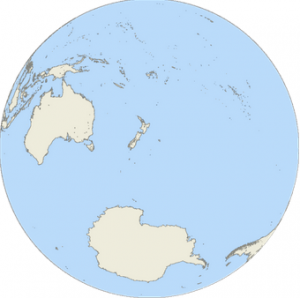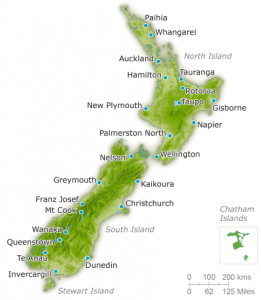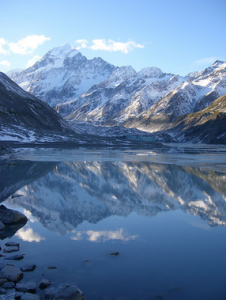New Zealand is made up of two main islands and a number of smaller islands in the South Pacific, near the centre of the water hemisphere, the half of the planet’s surface with the most water and the least land. In the image below you can see New Zealand to the right of Australia and above Antarctica. Hawaii is at the top edge just right of center, and the west coast of the USA is just over the horizon at about two o’clock. Because of its remoteness, NZ was one of the last lands to become settled by humans.
New Zealand is about a thousand miles long along its (mostly) vertical axis, with an area about equal to New York State and Pennsylvania combined. Texas is more than twice as large in area. The population is about 4.5M, roughly a quarter as many people as live in New York State. The population density is about 45 people per square mile, about half that of the USA, but four times more dense than Australia or Canada.
The North Island has about 40% of the land area of New Zealand, and about 77% of the population. The larger South Island is dominated by the Southern Alps range of mountains extending 450 km north to south. The tallest peak is Mount Cook, the highest point in New Zealand at 3,754 metres (12,316 ft) and there are sixteen other points in the range that exceed 3,000 metres (9,800 ft) in height.
New Zealand owes its existence to tectonic uplift and volcanos. Lake Taupo on the North Island, sits in the caldera of a supervolcano which last erupted 1,800 years ago. This eruption is estimated to have been the most violent on earth for the past 5000 years. There is much geothermal activity, especially on the North Island, similar to that found in the vicinity of our own Yellowstone caldera.
Next up: the Finger Lakes of New Zealand




good stuff, robert
The most fascinating part about New Zealand history is that it had no mammals until humans showed up. That’s why it had so many birds that couldn’t fly. Also, the white man and the Pacific islanders discovered New Zealand about the same time.
Thus, it was the rats and dogs the humans brought with them on their boats that wiped out much of the helpless bird population. (The humans ate them, too, because the birds wouldn’t even run away because they hadn’t learned fear.)
The birds that remain there remain the most fascinating in the world, however.
By the way, I was wondering… Why does New Zealand hate podes?